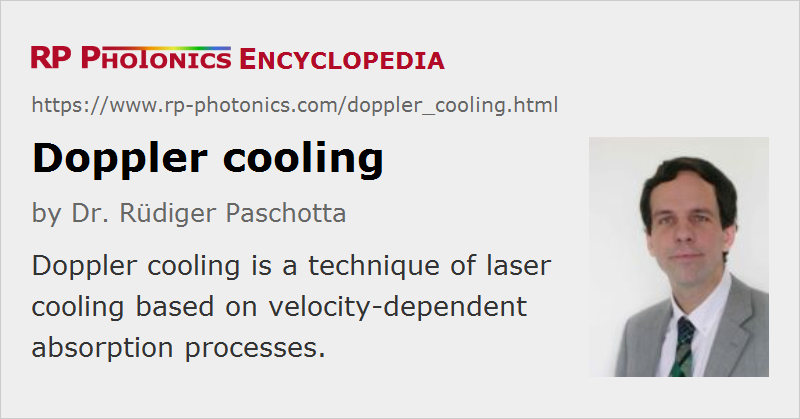Doppler Cooling
Definition: a technique of laser cooling based on velocity-dependent absorption processes
German: Doppler-Kühlung
Categories: quantum optics, methods
How to cite the article; suggest additional literature
Author: Dr. Rüdiger Paschotta
Doppler cooling is a technique for laser cooling of small particles (typically atoms or ions). The basic principle is that absorption and subsequent spontaneous emission of photons lead to light forces, and these forces become velocity-dependent through the Doppler effect: an absorption resonance of an atom or ion is shifted, e.g., towards lower frequencies when the particle is moving towards the light source. For example, a beam of atoms in a vacuum chamber can be stopped and cooled with a counterpropagating single-frequency laser beam, the optical frequency of which is first chosen to be somewhat higher than the atomic resonance, so that only the fastest atoms can absorb photons. Subsequently, the laser frequency is reduced so that slower and slower atoms participate in the interaction, and finally all atoms have a greatly reduced speed (at least in one dimension). This corresponds to a lower temperature, assuming that thermal equilibrium can be reestablished.
An alternative to sweeping the laser frequency is sweeping the atomic resonances via a spatially varying magnetic field (Zeeman slowing).
Doppler cooling can also be used in an arrangement called optical molasses, where cooling occurs in all three dimensions.
The minimum temperature achievable with Doppler cooling is the Doppler limit. In some cases, however, cooling well below the Doppler limit (down to the region of the recoil limit) has been observed and explained as Sisyphus cooling.
Questions and Comments from Users
Here you can submit questions and comments. As far as they get accepted by the author, they will appear above this paragraph together with the author’s answer. The author will decide on acceptance based on certain criteria. Essentially, the issue must be of sufficiently broad interest.
Please do not enter personal data here; we would otherwise delete it soon. (See also our privacy declaration.) If you wish to receive personal feedback or consultancy from the author, please contact him e.g. via e-mail.
By submitting the information, you give your consent to the potential publication of your inputs on our website according to our rules. (If you later retract your consent, we will delete those inputs.) As your inputs are first reviewed by the author, they may be published with some delay.
See also: Doppler broadening, optical molasses, laser cooling, Sisyphus cooling
and other articles in the categories quantum optics, methods
 |




If you like this page, please share the link with your friends and colleagues, e.g. via social media:
These sharing buttons are implemented in a privacy-friendly way!